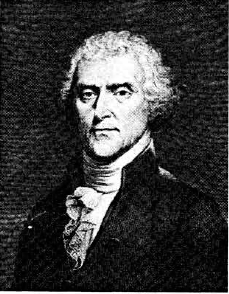Sometime prior to 22 March 1802, the brilliant scholar president, Thomas Jefferson, designed a magnificent wheel cipher, a device absolutely extraordinary and imaginative.[103] In his letter to Robert Patterson, he wrote that Patterson's cipher, sent to him several months earlier, was so much more convenient to use than his wheel cipher that he was proposing to James Madison, his secretary of state, to employ it for the department's correspondence. Although Patterson's cipher system offered splendid security, it was extremely time-consuming to encipher and decipher. Jefferson's cipher cylinder promised more prompt and efficient enciphered communications, provided the devices could be safely delivered to the correspondents.
Apparently Jefferson did nothing further with his cylinder, and the design was rediscovered among his papers in the Library of Congress in 1922. Someone else invented a similar system, and in that same year the U.S. Army adopted an almost identical device.[104]
Later, other government agencies would also adopt it, particularly the U.S. Navy. The measurements and other design specifications for this truly unique device were recorded by Jefferson as follows:[105]
Turn a cylinder of white wood of about 2. Inches diameter & 6. or 8. I. long, bore through it's [sic] center a hole sufficient to receive [sic] an iron spindle or axis of 1/8 or 1/4 I. diam. divide the periphery into 26. equal parts (for the 26. letters of the alphabet) and, with a sharp point, draw parallel lines through all the points of division, from one end to the other of the cylinder, & trace those lines with ink to make them plain, then cut the cylinder crosswise into pieces of about 1/6 of an inch thick, they will resemble back-gammon man with plan sides, number each of the, as they are cut off, on one side, that they may be arrangeable [sic] in any order your please, on the periphery of each, and between the black lines, put all the letters of the alphabet, not in their established order, but jumbled, & without order, so that no two shall be alike, now string them in their numerical order on an iron axis, one end of which has a head, and the other a nut and screw; the use of which is to hold them firm in any given position when you chuse it. they are now ready for use, your correspondent having a similar cylinder, similarly arranged.
Suppose I have to cypher this phrase, 'your favor of the 22d. is received'. I turn the 1st. wheel till the letter y. presents itself. I turn the 2d. & place it's o. by the side of the y. of the 1st. wheel. I turn the 3d. & place it's u. by the side of the o. of the 2d. 4th. & place it's r. by the side of the u. of the 3d. 5th. & place it's f. by the side of the r. of the 4th. 6th & place it's a. by the side of the f. of the 5th. and so on till I have got all the words of the phrase arranged in one line, fix them with the screw, you will observe that the cylinder then presents 25. other lines of letters not in any regular series, but jumbled, & without order or meaning, copy any one of them in the letter to your correspondent, when he receives it, he takes his cylinder and arranges the wheels so as to present the same jumbled letters in the same order in one line, he then fixes them with his screw, and examines the other 25. lines and finds one of them presenting him these letters 'yourfavorofthe22isreceived.' which he writes down, as the others will be jumbled & have no meaning, he cannot mistake the true one intended, so proceed with every other portion of the letter, numbers had better be represented by letters with dots over them; as for instance by the 6. vowels & 4. liquids, because if the periphery were divided into 36. instead of 26. lines for the numerical, as well as alphabetical characters, it would increase the trouble of finding the letters on the wheels.
When the cylinder of wheels is fixed with the jumbled alphabets on their peripheries, by only changing the order of the wheels in the cylinder, an immense variety of different cyphers may be produced for different correspondents, for whatever be the number of wheels, if you take all the natural numbers from unit to that inclusive, & multiply them successively into one another, their product will be the number of different combinations of which the wheels are susceptible, and consequently of the different cyphers they may form for different correspondents, entirely unintelligible to each other, for though every one possesses the cylinder, and the alphabets similarly arranged on the wheels, yet if the order be inverted, but one line, similar through the whole cylinder, can be produced on any two of them. 2. letters can form only 2. different series, viz. a.b. and b.a. say 1 × 22 add a 3d. letter, then it may be inverted in each of these two series as 1st.2d. or 3d. letter of the series, to wit c.a.b./ c.b.a. [Jefferson continues at the top of the next page].
Without doubt, as David Kahn, the masterful historian of cryptography, states, Jefferson deserves the title of "Father of American Cryptography" because his design is so significant. The Jefferson wheel cipher was the most advanced cipher of its era. Indeed, this development elevates Jefferson to a height above Blaise de Vigenére and Girolamo Cardano, two brilliant architects in the design of secret writing.

